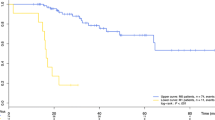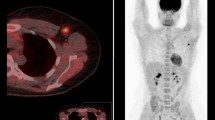Abstract
Purpose
To investigate the value of response monitoring in both the primary tumour and axillary nodes on sequential PET/CT scans during neoadjuvant chemotherapy (NAC) for predicting complete pathological response (pCR), taking the breast cancer subtype into account.
Methods
In 107 consecutive patients 290 PET/CT scans were performed at baseline (PET/CT1, 107 patients), after 2 – 3 weeks of chemotherapy (PET/CT2, 85 patients), and after 6 – 8 weeks (PET/CT3, 98 patients). The relative changes in SUVmax (from baseline) of the tumour and the lymph nodes and in both combined (after logistic regression), and the changes in the highest SUVmax between scans (either tumour or lymph node) were determined and their associations with pCR of the tumour and lymph nodes after completion of NAC were assessed using receiver operating characteristic (ROC) analysis.
Results
A pCR was seen in 17 HER2-positive tumours (65 %), 1 ER-positive/HER2-negative tumour (2 %), and 16 triple-negative tumours (52 %). The areas under the ROC curves (ROC-AUC) for the prediction of pCR in HER2-positive tumours after 3 weeks were 0.61 for the relative change in tumours, 0.67 for the combined change in tumour and nodes, and 0.72 for the changes in the highest SUVmax between scans. After 8 weeks equivalent values were 0.59, 0.42 and 0.64, respectively. In triple-negative tumours the ROC-AUCs were 0.76, 0.84 and 0.76 after 2 weeks, and 0.87, 0.93 and 0.88 after 6 weeks, respectively.
Conclusion
In triple-negative tumours a PET/CT scan after 6 weeks (three cycles) appears to be optimally predictive of pCR. In HER2-positive tumours neither a PET/CT scan after 3 weeks nor after 8 weeks seems to be useful. The changes in SUVmax of both the tumour and axillary nodes combined correlates best with pCR.



Similar content being viewed by others
References
Kaufmann M, von Minckwitz G, Mamounas EP, Cameron D, Carey LA, Cristofanilli M, et al. Recommendations from an international consensus conference on the current status and future of neoadjuvant systemic therapy in primary breast cancer. Ann Surg Oncol. 2012;19:1508–16.
Rastogi P, Anderson SJ, Bear HD, Geyer CE, Kahlenberg MS, Robidoux A, et al. Preoperative chemotherapy: updates of National Surgical Adjuvant Breast and Bowel Project Protocols B-18 and B-27. J Clin Oncol. 2008;26:778–85.
Fisher B, Bryant J, Wolmark N, Mamounas E, Brown A, Fisher ER, et al. Effect of preoperative chemotherapy on the outcome of women with operable breast cancer. J Clin Oncol. 1998;16:2672–85.
Mieog JSD, van der Hage JA, van de Velde CJH. Neoadjuvant chemotherapy for operable breast cancer. Br J Surg. 2007;94:1189–200.
von Minckwitz G, Untch M, Blohmer JU, Costa SD, Eidtmann H, Fasching PA, et al. Definition and impact of pathologic complete response on prognosis after neoadjuvant chemotherapy in various intrinsic breast cancer subtypes. J Clin Oncol. 2012;30:1796–804.
von Minckwitz G, Blohmer JU, Costa S, Denkert C, Eidtmann H, Eiermann W, et al. Neoadjuvant chemotherapy adapted by interim response improves overall survival of primary breast cancer patients – results of the GeparTrio trial. Abstract S3-2, presented at the San Antonio Breast Cancer Symposium, San Antonio TX, USA, December 2011.
Loo CE, Straver ME, Rodenhuis S, Muller SH, Wesseling J, Vrancken Peeters MJTFD, et al. Magnetic resonance imaging response monitoring of breast cancer during neoadjuvant chemotherapy: relevance of breast cancer subtype. J Clin Oncol. 2011;29:660–6.
Koolen BB, Vrancken Peeters MJTFD, Aukema TS, Vogel WV, Oldenburg HSA, van der Hage JA, et al. 18F-FDG PET/CT as a staging procedure in primary stage II and III breast cancer: comparison with conventional imaging techniques. Breast Cancer Res Treat. 2012;131:117–26.
Koolen BB, Valdés Olmos RA, Elkhuizen PHM, Vogel WV, Vrancken Peeters M-JTFD, Rodenhuis S, et al. Locoregional lymph node involvement on 18F-FDG PET/CT in breast cancer patients scheduled for neoadjuvant chemotherapy. Breast Cancer Res Treat. 2012;135:231–40.
Pritchard KI, Julian JA, Holloway CMB, McCready D, Gulenchyn KY, George R, et al. Prospective study of 2-[18F]fluorodeoxyglucose positron emission tomography in the assessment of regional nodal spread of disease in patients with breast cancer: an Ontario clinical oncology group study. J Clin Oncol. 2012;30:1274–79.
Wahl RL, Zasadny K, Helvie M, Hutchins GD, Weber B, Cody R. Metabolic monitoring of breast cancer chemohormonotherapy using positron emission tomography: initial evaluation. J Clin Oncol. 1993;11:2101–11.
Rousseau C, Devillers A, Sagan C, Ferrer L, Bridji B, Campion L, et al. Monitoring of early response to neoadjuvant chemotherapy in stage II and III breast cancer by [18F]fluorodeoxyglucose positron emission tomography. J Clin Oncol. 2006;24:5366–72.
McDermott GM, Welch A, Staff RT, Gilbert FJ, Schweiger L, Semple SIK, et al. Monitoring primary breast cancer throughout chemotherapy using FDG-PET. Breast Cancer Res Treat. 2007;102:75–84.
Schwarz-Dose J, Untch M, Tiling R, Sassen S, Mahner S, Kahlert S, et al. Monitoring primary systemic therapy of large and locally advanced breast cancer by using sequential positron emission tomography imaging with [18F]fluorodeoxyglucose. J Clin Oncol. 2009;27:535–41.
Groheux D, Hindié E, Giacchetti S, Delord M, Hamy AS, de Roquancourt A, et al. Triple-negative breast cancer: early assessment with 18F-FDG PET/CT during neoadjuvant chemotherapy identifies patients who are unlikely to achieve a pathologic complete response and are at a high risk of early relapse. J Nucl Med. 2012;53:249–54.
Kolesnikov-Gauthier H, Vanlemmens L, Baranzelli MC, Vennin P, Servent V, Fournier C, et al. Predictive value of neoadjuvant chemotherapy failure in breast cancer using FDG-PET after the first course. Breast Cancer Res Treat. 2012;131:517–25.
Wang Y, Zhang C, Liu J, Huang G. Is 18F-FDG PET accurate to predict neoadjuvant therapy response in breast cancer? A meta-analysis. Breast Cancer Res Treat. 2012;131:357–69.
Humbert O, Berriolo-Riedinger A, Riedinger JM, Coudert B, Arnould L, Cochet A, et al. Changes in 18F-FDG tumor metabolism after a first course of neoadjuvant chemotherapy in breast cancer: influence of tumor subtypes. Ann Oncol. 2012;23:2572–77.
Koolen BB, Pengel KE, Wesseling J, Vogel WV, Vrancken Peeters MJTFD, Vincent AD, et al. FDG PET/CT during neoadjuvant chemotherapy may predict response in ER-positive/HER2-negative and triple negative, but not in HER2-positive breast cancer. Breast. 2013. doi:10.1016/j.breast.2012.12.020.
Untch M, von Minckwitz G. Neoadjuvant chemotherapy: early response as a guide for further treatment: clinical, radiological, and biological. J Natl Cancer Inst Monogr. 2011;2011:138–41.
Rousseau C, Devillers A, Campone M, Campion L, Ferrer L, Sagan C, et al. FDG PET evaluation of early axillary lymph node response to neoadjuvant chemotherapy in stage II and III breast cancer patients. Eur J Nucl Med Mol Imaging. 2011;38:1029–36.
Sonke GS, Mandjes IA, Holtkamp M, Schot M, van Werkhoven E, Wesseling J, et al. Paclitaxel, carboplatin, and trastuzumab in a neoadjuvant regimen for HER2-positive breast cancer. Breast J. 2013;19:419–26.
Loo CE, Teertstra HJ, Rodenhuis S, van de Vijver MJ, Hannemann J, Muller SH, et al. Dynamic contrast-enhanced MRI for prediction of breast cancer response to neoadjuvant chemotherapy: initial results. AJR Am J Roentgenol. 2008;191:1331–8.
Vidal-Sicart S, Aukema TS, Vogel WV, Hoefnagel CA, Valdés-Olmos RA. Added value of prone position technique for PET-TAC in breast cancer patients. Rev Esp Med Nucl. 2010;29:230–5.
Boellaard R, Oyen WJG, Hoekstra CJ, Hoekstra OS, Visser EP, Willemsen AT, et al. The Netherlands protocol for standardisation and quantification of FDG whole body PET studies in multi-centre trials. Eur J Nucl Med Mol Imaging. 2008;35:2320–33.
Wahl RL, Jacene H, Kasamon Y, Lodge MA. From RECIST to PERCIST: evolving considerations for PET response criteria in solid tumors. J Nucl Med. 2009;50 Suppl 1:122S–50S.
DeLong ER, DeLong DM, Clarke-Pearson DL. Comparing the areas under two or more correlated receiver operating characteristic curves: a nonparametric approach. Biometrics. 1988;44:837–45.
Martoni AA, Zamagni C, Quercia S, Rosati M, Cacciari N, Bernardi A, et al. Early (18)F-2-fluoro-2-deoxy-d-glucose positron emission tomography may identify a subset of patients with estrogen receptor-positive breast cancer who will not respond optimally to preoperative chemotherapy. Cancer. 2010;116:805–13.
Koolen BB, Valdés Olmos RA, Wesseling J, Vogel WV, Vincent AD, Gilhuijs KG, et al. Early assessment of axillary response with 18F-FDG PET/CT during neoadjuvant chemotherapy in stage II-III breast cancer: implications for surgical management of the axilla. Ann Surg Oncol. 2013;20:2227–35.
Straver ME, Rutgers EJT, Rodenhuis S, Linn SC, Loo CE, Wesseling J, et al. The relevance of breast cancer subtypes in the outcome of neoadjuvant chemotherapy. Ann Surg Oncol. 2010;17:2411–18.
Gianni L, Eiermann W, Semiglazov V, Manikhas A, Lluch A, Tjulandin S, et al. Neoadjuvant chemotherapy with trastuzumab followed by adjuvant trastuzumab versus neoadjuvant chemotherapy alone, in patients with HER2-positive locally advanced breast cancer (the NOAH trial): a randomised controlled superiority trial with a parallel HER2-negative cohort. Lancet. 2010;375:377–84.
Koolen BB, Vrancken Peeters MJTFD, Wesseling J, Lips EH, Vogel WV, Aukema TS, et al. Association of primary tumour FDG uptake with clinical, histopathological and molecular characteristics in breast cancer patients scheduled for neoadjuvant chemotherapy. Eur J Nucl Med Mol Imaging. 2012;39:1830–8.
Acknowledgments
This study was performed within the framework of CTMM, the Center for Translational Molecular Medicine (www.ctmm.nl), project Breast CARE (grant 03O-104). We are grateful to Marjo Holtkamp, Margaret Schot and Jacqueline van Zyll de Jong for their active participation and guidance of patients throughout this study.
Disclosure
This study was performed within the framework of CTMM, the Center for Translational Molecular Medicine (www.ctmm.nl); project Breast CARE (grant 03O-104).
Author information
Authors and Affiliations
Corresponding author
Electronic supplementary material
Below is the link to the electronic supplementary material.
ESM Table S1
PET/CT findings before and during NAC per subtype. (DOC 86 kb)
ESM Fig. S 1
Chemotherapy regimens as used in this study. HER2-positive tumours were treated with PTC in three cycles of eight weekly administrations. Interim PET/CT scans were performed after three and eight administrations (3 and 8 weeks). HER2-negative tumours were treated with six cycles of AC in a dose-dense schedule (every 2 weeks). Interim PET/CT scans were performed after one and three cycles (2 and 6 weeks). In HER2-negative patients, a switch in chemotherapy regimen was done after the third PET/CT scan. HER2 human epidermal growth factor receptor 2, PTC paclitaxel, trastuzumab and carboplatin, T trastuzumab, AC cyclophosphamide and doxorubicin (JPEG 396 kb)
Rights and permissions
About this article
Cite this article
Koolen, B.B., Pengel, K.E., Wesseling, J. et al. Sequential 18F-FDG PET/CT for early prediction of complete pathological response in breast and axilla during neoadjuvant chemotherapy. Eur J Nucl Med Mol Imaging 41, 32–40 (2014). https://doi.org/10.1007/s00259-013-2515-7
Received:
Accepted:
Published:
Issue Date:
DOI: https://doi.org/10.1007/s00259-013-2515-7




